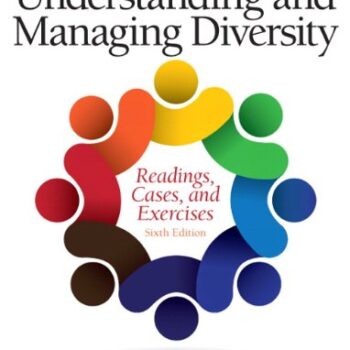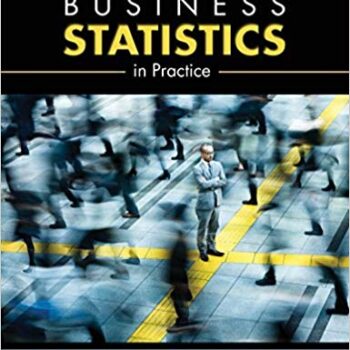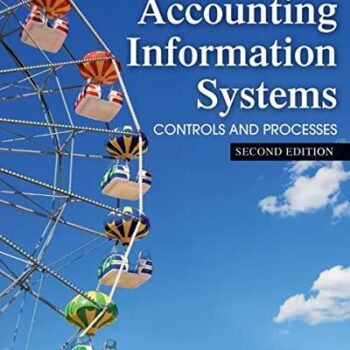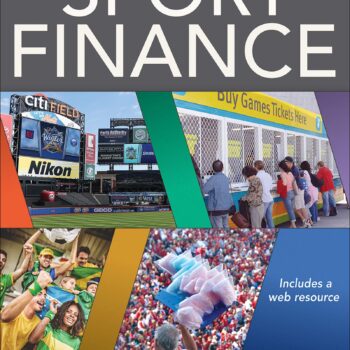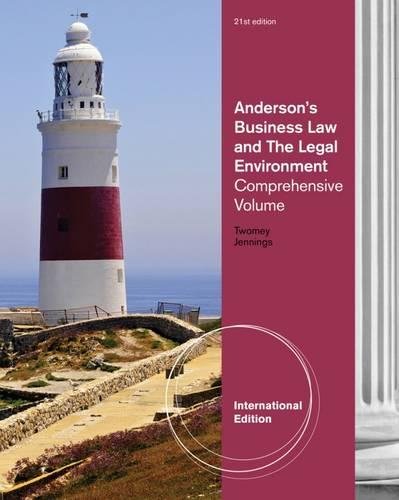
Test Bank For Anderson’s Business Law and the Legal Environment: Comprehensive, International Edition
Original price was: $55.00.$20.00Current price is: $20.00.
Digital item No Waiting Time Instant DownloadISBN-10 : 0538749903ISBN-13 : 978-0538749909Publisher : South-Western; 21st editionAuthors: David P. Twomey, Marianne Jennings
A great recommendation to supplement your studies and preparation for Anderson’s Business Law and the Legal Environment: Comprehensive, International Edition is to utilize the Test bank. It contains a collection of questions on core concepts of law, ethics, business, contracts, and the like. Thus, you will be offered a set of relevant multiple-choice test questions that will give you a simulated exam experience and therefore enhance your strength and performance.
What’s Inside the Test Bank?
The test bank comprises questions that correspond to each chapter of the course book and in this case, the textbook topics under coverage are:
- Business Ethics and Social Responsibility
- Contracts: Formation, performance and remedies
- Agency and Employment Law
- Intellectual Property Rights
- Corporate Law and partnerships
- Real Property Law and Environmental Law
This includes the everyday workings of legal problems and features: multiple-choice questions, true or false questions, and various cases, for instance, the case concerning the U.S. Constitution, the case of negotiable instruments, a case of government regulation. Such practice questions make the comprehension of difficult legal concepts easier.
Why Use This Test Bank?
The test bank has numerous advantages:
- Exams preparation: The problem with that feeling of greater significance that tends to accompany many students best explains the major problem with exam revision and preparation practice is ideal when the questions are realistic in form.
- Understand Important Legal Concepts: More difficult concepts like torts, contract law, and business organizations are simplified into easy segments.
- Self-directed Learning: As you learn, test yourself and find out where you need to improve.
- Step-by-Step Guides: Many test banks offer key answers to questions that guide you through the process of arriving at the correct solution.
How This Test Bank Assists Students in Achieving Their Goals.
The Anderson’s Business Law test bank has been created for students with a professional Law background and assists them in comprehending complex Legal theories with ease. It balances principle and practice. This includes law case history, statutory law, and consumer law which enables a student to respond to textbook questions as well as practical ones.
For those of you who are looking to have a basic understanding of business law or are looking for study materials for professional exams, this test bank would be ideal as it complements the textbook explanations extremely well. It also assists students in acquiring knowledge in other areas of contracts, employment law, sales of goods, and contracts.
Chapter 1—THE NATURE AND SOURCES OF LAW
TRUE/FALSE
The pattern of rules that society uses to control the conduct of individuals in their relationships is called law.
ANS: TMSC: AACSB Analytic
Law is often defined as the body of principles that courts will enforce.
ANS: TMSC: AACSB Analytic
One of our most important rights is the right to privacy.
ANS: TMSC: AACSB Analytic
The United States Constitution provides that we have a right to be free from intrusions by others.
ANS: TMSC: AACSB Analytic
Several layers of law are enacted at different levels of government to provide the framework for business and personal rights and duties. At the base of this framework of laws is constitutional law.
ANS: TMSC: AACSB Analytic
A constitution is a body of principles that establishes the structure of a government and the relationship of that government to the people who are governed.
ANS: TMSC: AACSB Analytic
In addition to state legislatures and the United States Congress, all cities, counties, and other governmental subdivisions have some power to adopt ordinances within their sphere of operation.
ANS: TMSC: AACSB Analytic
Administrative regulations are a type of law.
ANS: TMSC: AACSB Analytic
Courts can create law.
ANS: TMSC: AACSB Analytic
When a court decides on a new question or problem, the decision is called a precedent.
ANS: TMSC: AACSB Analytic
The group of time-honored rules that courts have used to solve similar problems for decades is called stare decisis.
ANS: TMSC: AACSB Analytic
Jane asserts she has a legal right. Jane is saying she must perform or refrain from performing an act.
ANS: FTOP: MSC: AACSB Analytic
Rights guaranteed in the United States Constitution are not accompanied by duties.
ANS: FMSC: AACSB Analytic
Rights always stand alone, without any duties.
ANS: FMSC: AACSB Analytic
Court decisions and statutes can take away rights created by the United States Constitution.
ANS: FMSC: AACSB Analytic
The right to be secure against unreasonable searches and seizures conducted by the police is guaranteed by state statute.
ANS: FMSC: AACSB Analytic
The private life of a nonpublic citizen is subject to public scrutiny.
ANS: FMSC: AACSB Analytic
One advantage of our current legal system is that the growth of technology has not created many new laws.
ANS: FMSC: AACSB Analytic
The right to privacy does not apply to intrusions into our privacy using new technology.
ANS: FMSC: AACSB Analytic
Statutes are the only source of law.
ANS: FMSC: AACSB Analytic
Within each state in the United States, only one constitution is in force.
ANS: FMSC: AACSB Analytic
State legislatures, not Congress, enact statutory law.
ANS: FMSC: AACSB Analytic
Administrative regulations generally do not have the force of a statute.
ANS: FMSC: AACSB Analytic

